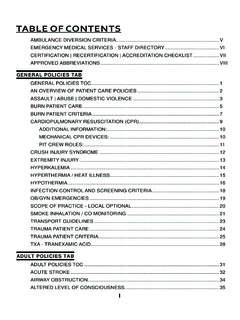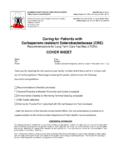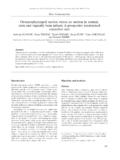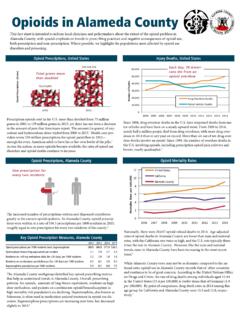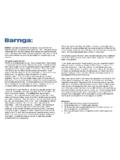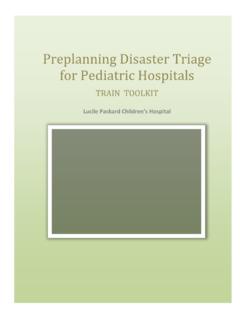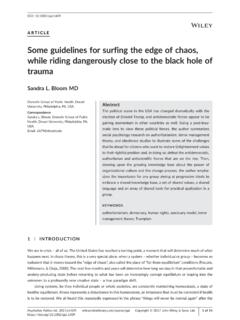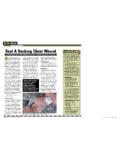Transcription of Management of Open Pneumothorax in Tactical …
1 81 Management of open Pneumothorax in Tactical Combat Casualty Care:TCCC Guidelines Change 13-02 Frank K. Butler, MD; Joseph J. Dubose, MD; Edward J. Otten, MD; Donald R. Bennett, MD; Robert T. Gerhardt, MD; Bijan S. Kheirabadi, PhD; Kirby R. Gross, MD; Andrew P. Cap, MD; Lanny F. Littlejohn, MD; Erin P. Edgar, MD; Stacy A. Shackelford, MD; Lorne H. Blackbourne, MD; Russ S. Kotwal, MD; John B. Holcomb, MD; Jeffrey A. Bailey, MDABSTRACTD uring the recent United States Central Command (US-CENTCOM) and Joint Trauma System (JTS) assessment of prehospital trauma care in Afghanistan, the deployed director of the Joint Theater Trauma System (JTTS), CAPT Donald R.
2 Bennett, questioned why TCCC recom-mends treating a nonlethal injury ( open Pneumothorax ) with an intervention (a nonvented chest seal) that could produce a lethal condition (tension Pneumothorax ). New research from the Army Institute of Surgical Research (USAISR) has found that, in a model of open Pneumothorax treated with a chest seal in which incre-ments of air were added to the pleural space to simulate an air leak from an injured lung, use of a vented chest seal prevented the subsequent development of a tension Pneumothorax , whereas use of a nonvented chest seal did not. The updated TCCC Guideline for the battlefield Management of open Pneumothorax is: All open and/or sucking chest wounds should be treated by immedi-ately applying a vented chest seal to cover the defect.
3 If a vented chest seal is not available, use a non-vented chest seal. Monitor the casualty for the potential development of a subsequent tension Pneumothorax . If the casualty develops increasing hypoxia, respiratory distress, or hypotension and a tension Pneumothorax is suspected, treat by burping or removing the dressing or by needle decompression. This recommendation was approved by the required two-thirds majority of the Committee on TCCC in June : Pneumothorax , chest seal, TCCC GuidelineProximate Cause for the Proposed ChangeDuring the recent United States Central Command ( USCENTCOM) and Joint Trauma System (JTS) as-sessment of prehospital trauma care in Afghanistan, the deployed director of the Joint Theater Trauma System (JTTS), CAPT Donald Bennett, questioned why TCCC recommends treating a nonlethal injury ( open pneumo-thorax) with an intervention (a nonvented chest seal) that could produce a lethal condition (tension Pneumothorax ).
4 1 New research from the Army Institute of Surgical Re-search (USAISR) has found that, in a model of open pneu-mothorax treated with a chest seal in which increments of air were added to the pleural space to simulate an air leak from an injured lung, use of a vented chest seal prevented the subsequent development of a tension Pneumothorax , whereas use of a nonvented chest seal did TCCC Guidelines call for an open pneumo-thorax (sucking chest wound) to be treated with an oc-clusive chest seal followed by careful monitoring of the casualty for the possible subsequent development of a tension Pneumothorax . If a tension Pneumothorax is suspected, the casualty should be managed by burping the occlusive dressing, thus allowing air to escape from the pleural cavity, or by needle decompression of the There is no mention in the guidelines at present of whether the chest seal should or should not be the recent USCENTCOM/JTS assessment of prehospital trauma care in Afghanistan, the Deployed Director of the Joint Theater Trauma System (JTTS), CAPT Don Bennett, recommended that this aspect of the TCCC recommendations be To quote from this report.
5 Chest Seals ( Asherman, Bolin, Halo, Hy-fin, Russell, Sam) are variable in their adhesive abilities. Is the flutter valve beneficial? (Role I USMC/USN) Is the chest seal itself benefi-cial? Or, does it convert a sucking chest wound into a life-threatening tension Pneumothorax ? Why do we treat a non-lethal condition ( open 82 Journal of Special Operations Medicine Volume 13, Edition 3/Fall 2013pneumothorax) with an intervention that may result in a lethal condition (tension pneumotho-rax)? (incoming JTTS deployed director) There were no fatalities during OEF and OIF attributed to isolated open It is a matter of spec-ulation as to whether discontinuing the current practice of treating open pneumothoraces with an occlusive chest seal might have caused There were 11 deaths from tension Pneumothorax reported in the Eastridge Two of the 11 deaths from tension pneumotho-rax were associated with the use of a 2-inch needle for chest decompression and failure of the needle to enter the pleural It is not known whether any of these 11 deaths were associated with an open Pneumothorax that was treated with an occlusive chest seal and
6 Con-verted to a tension Pneumothorax . Use of the shorter 2-inch needles was discontinued in the military after the findings noted by Dr. Harcke. The recommended needle for decompression of suspected Pneumothorax at present is a 14-gauge ,6In a recent study of thoracic trauma from Iraq and Af-ghanistan, the authors noted that: The mortality rate among all patients identified with thoracic trauma was Patients with flail chest, thoracic vascular in-juries, hemothorax, or pulmonary lacerations had the highest mortality rates. Contusions, Pneumothorax , flail chest, and chest wall trauma were associated with a lower mortality risk when controlling for covariates.
7 Thoracic vascular injury was the diagnosis associated with the highest mortality risk. 7 Discussion PointsHistorical BackgroundIn World War I, Primary closure of open pneumotho-rax, albeit without drainage, was a widely accepted prac-tice. 8 The pathophysiology of open Pneumothorax was described during World War II: When a chest wall in-jury extends through the parietal pleura into the pleural cavity (normally only a potential space), two openings are present to admit air into the thorax. While on inspi-ration air enters the chest through both of these open -ings, it is only by way of the trachea and bronchi that air, with its necessary oxygen, can reach the pulmonary al-veoli.
8 It is evident that the percentage of air that reaches the lungs through the trachea is in inverse proportion to the size of the chest wall opening. When this differential is sufficiently great, not enough oxygen is available to sustain life even with the deepest inspiratory effort. The prompt application of a reasonably air-tight dressing to close the chest wall opening averts this disaster. 9 The emphasis in early reports describing the treatment of open Pneumothorax was in closing the chest wall defect, without discussion of the potential development of a subse-quent tension 14 This approach was echoed by Edgecomb in 1964: Sucking Wounds of the Chest: If a wound of the chest wall communicates with the pleural cavity, there is usually an audible passage of air during both phases of respiration.
9 When present, the opening should be occluded immediately with a sterile dressing and held in place either manually or with additional dressings until the patient is transported to the operating room where under endotracheal anesthesia and aseptic conditions, the wound can be closed properly, airtight and with proper drainage. 15 West noted a mortality of 33% in 30 casualties with sucking chest wounds. The deaths were predominantly due to hemorrhage or The potential for the development of a secondary tension Pneumothorax after treatment of an open Pneumothorax was noted by Sny-der in his report on wartime injuries of the danger of converting an open Pneumothorax to a tension Pneumothorax through the use of an occlusive dressing was demonstrated in a case report by Haynes.
10 The author states: Although the entities of tension Pneumothorax and open Pneumothorax have been ad-equately described individually, their association pro-duced by emergency occlusive dressing in penetrating injuries of the chest has not been adequately stressed. 18 The possibility of a secondary tension Pneumothorax af-ter treatment of an open Pneumothorax was noted by Sellors in his review of a textbook on thoracic injuries by Lawrence M. Shafts in a canine model, animals with bilateral open chest wounds without positive pressure ventilation had either a 1-way valve dressing or petrolatum gauze applied to the wounds.



